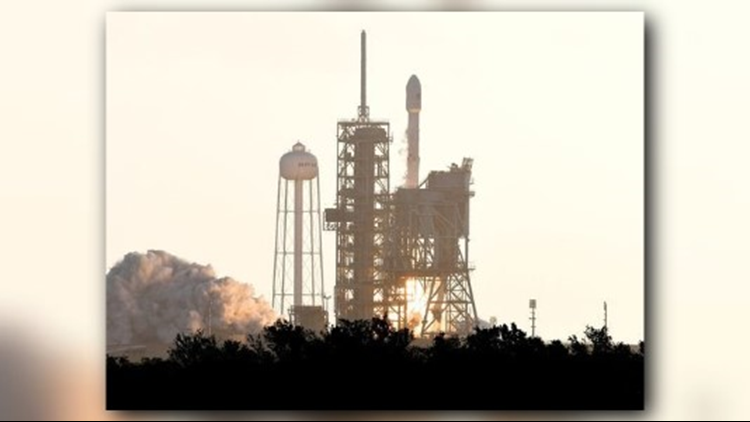SpaceX sent a classified U.S. spy agency mission on its way to orbit Monday morning, then brought the rocket’s first stage home for a landing, possibly to fly again.
A 230-foot Falcon 9 rocket blasted off from NASA's Kennedy Space Center at 7:15 a.m. ET, thundering northeast over the Atlantic Ocean with a U.S. National Reconnaissance Office mission labeled NROL-76.
The flight appeared to be off to a good start, but SpaceX cut off its launch broadcast a few minutes into the flight to help preserve its secrecy, as is standard practice during NRO missions.
SpaceX CEO Elon Musk said on Twitter that the mission launched successfully after nearly being scrubbed by strong high-altitude winds.
“Launch and landing of the NRO spy satellite was good,” he said about 20 minutes after liftoff. “Tough call, as high altitude wind shear was at 98.6% of the theoretical load limit.”
While coverage of the mission’s climb to space ended early, cameras showed spectacular footage of the 15-story Falcon booster flipping around and firing several engines to fly back to a pad at Cape Canaveral Air Force Station, several miles south of the launch site.
Dropping from more than 80 miles up, where camera views showed the blackness of space curvature of Earth, the stage deployed stabilizing fins and fired several engines again to slow its descent.
Falcon 9 first stage has landed at LZ-1 https://t.co/gtC39uBC7z pic.twitter.com/766RxdZ99X
— SpaceX (@SpaceX) May 1, 2017
Four legs snapped out from the base of the rocket, which completed a final single-engine burn before a touchdown at “Landing Zone 1” announced with a flurry of sonic booms that rippled across the region.
SpaceX has now reached double-digits in rocket landings that started in late 2015, recovering the first stage of a Falcon for the 10th time — four on land and six on a barge at sea.
In March, SpaceX successfully re-launched a used booster — or “flight proven,” in SpaceX terminology — for the first time for a commercial satellite mission. More reflights are possible this year, and SpaceX has leased a Port Canaveral facility to accommodate what Musk has said is a growing "forest of rocket boosters."
Musk believes reusable rockets are the key to drastically cutting launch costs, eventually making it possible to fulfill his vision of colonizing Mars.
Monday’s launch, after a sensor problem scrubbed a first try Sunday, was SpaceX’s first dedicated mission for the NRO, the intelligence agency responsible for satellites.
he NRO confirmed the mission was ordered as part of a satellite deal with Colorado-based Ball Aerospace, according to SpaceflightNow.com.
That information, combined with knowledge of the Falcon 9 rocket’s performance and trajectory, prompted amateur satellite observers experienced in tracking NRO missions to speculate that the mission might be an imaging satellite, bound for a low-Earth orbit inclined 50 to 60 degrees relative to the equator.
The mission patch, according to the National Reconnaissance Office, depicted Lewis and Clark peering through a spyglass and holding a musket, "heading into the great unknown to discover and explore the newly purchased Louisiana Territory."
Stuck the landing! Great job team! pic.twitter.com/mS09TvJsv9
— 45th Space Wing (@45thSpaceWing) May 1, 2017
If the speculation is correct, the satellite could be a replacement or successor to one launched in 2006 that failed immediately after reaching orbit.
That mission became a controversial one when the government chose to shoot down the satellite with a Navy missile in 2008, saying it posed a risk of releasing a large amount of highly toxic fuel during an uncontrolled re-entry.
The launch was SpaceX’s fifth this year, continuing its rebound from a launch pad rocket explosion last summer that grounded the company for the last four months of 2016.
Another Falcon 9 is being prepared to launch a commercial satellite from Kennedy Space Center as soon as May 15.



